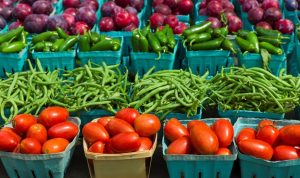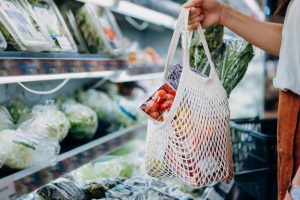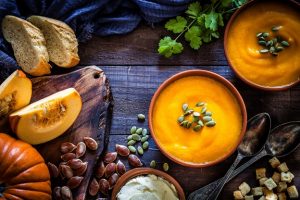Eating Fruits and Vegetables on a Budget
Written By Gwen Simms, Registered Dietitian
Do you want to eat more fruits and vegetables but are struggling to meet the daily recommendations? Canada’s Food Guide recommends filling half our plates with fruits and vegetables at each meal. This helps us meet certain vitamin, nutrient, and fibre needs to promote good gut health and prevent or manage many health conditions such as cardiovascular disease and diabetes.
Many Canadians want to increase their intake of vegetables and fruit, but struggle for a variety of reasons. Three of the most common challenges that I hear about from people every day are:
- They have no time to prepare vegetables
- They are unsure of how to prepare produce in tasty ways
- Vegetables and fruit are too expensive
 We all know how important fruits and vegetables are in supporting our overall health, but with current rising food costs, the price of fruits and vegetables is becoming a challenge for more and more families. So, the question we are left with is, how do we eat more fruits and veggies without breaking the bank?
While there is nothing more important than having adequate wages to cover our daily living costs, there are a few strategies we can incorporate that some may find helpful when it comes to getting the most bang for your buck at the grocery store.
We all know how important fruits and vegetables are in supporting our overall health, but with current rising food costs, the price of fruits and vegetables is becoming a challenge for more and more families. So, the question we are left with is, how do we eat more fruits and veggies without breaking the bank?
While there is nothing more important than having adequate wages to cover our daily living costs, there are a few strategies we can incorporate that some may find helpful when it comes to getting the most bang for your buck at the grocery store.
Check your fridge and freezer before shopping
Take an inventory of what produce you already have on hand. What needs to be used and how can you include it in your food plan for the week? This can be a great way to avoid food waste and ensure you are not buying more than you need.
Check flyers for sales, coupons, or deals
This can help you determine which fruits and vegetables are most likely to fit within your food budget for the week and you can meal plan around them.
The Flipp app (https://flipp.com/home) is a great resource to find out what is on sale at stores near you. Although paper flyers or coupons work just as well!
Make a plan
Once you know what you already have on hand and what is on sale, you can start to make a plan and build a list of produce to purchase. Having a general idea of what you want to purchase and what you can make with those fruits and vegetables can be a helpful way to make sure you end up using what you buy.
 Prioritize fruits and vegetables in your food budget
Take stock of how often you are purchasing restaurant meals, take-out, convenience foods, or specialty coffees and consider if you can reduce some of these purchases in order to spend more on fruits and vegetables.
Prioritize fruits and vegetables in your food budget
Take stock of how often you are purchasing restaurant meals, take-out, convenience foods, or specialty coffees and consider if you can reduce some of these purchases in order to spend more on fruits and vegetables.
Choose frozen or canned options
These options can be just as nutritious and often much cheaper than produce that is not in season. Just make sure to rinse off any canned products to remove added salt or sugar before using.
Buying store brand or no name brands of frozen or canned options also tends to be less expensive.
 Check out the clearance section
Check out the clearance section
You can save quite a bit by looking at what is on offer in the clearance section and being a little creative in how you can use these ‘reduced’ options. Vegetables that have seen better days can be added to soups or stews and overly ripe fruit can be used to bake with, turned into fruit sauces, or added to smoothies.
Buy local and seasonal produce
Fruits and vegetables in season are usually cheaper. Local produce also tends to be more affordable than imported options. Another helpful tip is to buy fresh produce in varying stages of ripeness to help make sure they last all week and avoid any food waste.
Foodland Ontario has a helpful availability guide that highlights when certain fruits and vegetables are in season in Ontario (https://www.ontario.ca/foodland/page/availability-guide).
Stock up on favourites when they are on sale
Take advantage of sales when you can if you have the freezer and pantry space to store them properly. If you find a great deal on fresh produce, you can always wash, chop, and freeze for use at a later date.
Visit ‘Half Your Plate’ website:
The Half Your Plate website is an amazing resource for recipes, information, and tips and tricks to help you increase your fruit and vegetable intake.
They also have a fantastic new section on their website called ‘What Can $20 Get You?’ where they look at how much fruit and vegetables you can buy with $20 in a different Canadian city each week.
Carrot and Squash Ginger Soup Recipe 

Makes: 6 servings
Prep time: 20 minutes
Cook time: 30 minutes
Ingredients:
2 tsp olive oil
2 cups chopped carrots
1 large onion, chopped
2 tbsp ginger, minced
1 clove garlic, minced
1 lb butternut squash, peeled and cubed
1 Granny Smith apple, peeled, cored, and chopped (any apple you have on hand will do)
2 tsp lemon juice
4 cups no salt added chicken or vegetable broth
Directions:
1. In large saucepan heat oil over medium heat. Sweat carrots, onion, ginger, and garlic, stirring until softened, about 6 minutes.
2. Stir in the squash, apple, lemon juice, salt, and pepper. Cook, stirring for 2 minutes.
3. Add broth and bring to a boil. Reduce heat, cover and simmer, stirring occasionally until tender, 25-30 minutes.
4. Puree using immersion blender or in batches with a blender.

